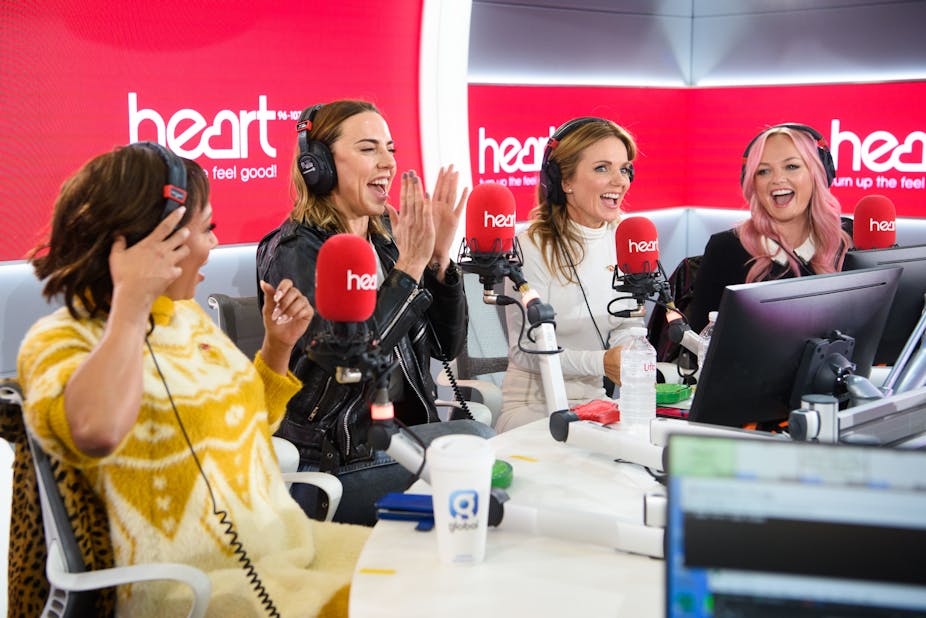More than 20 years after their heyday – and ten years after their first reunion – the Spice Girls are coming back again. The last time round they tried to update their image and revamp their brand: the 2007 single Headlines (Friendship Never Ends) and the quickly-abandoned GEM project (which was just Geri Halliwell, Emma Bunton and Melanie Brown) appear to have been attempts to present a new, more adult, version of the group. But, for their 2019 tour, the Spice Girls appear to going back to what they always did best.
For the first time since Geri left in 1998 – breaking the heart of every little girl in the process (including mine) – they have stopped trying to grow up and are reconnecting with the thing that made them a hit in the 1990s: childhood.
The clues were in the official announcement video. Its only focus was nostalgia, from the very first words spoken: “Girls, do you think I’m too old for bunches?” Naturally, Bunton’s hair was in bunches before the announcement was over, reassuring everyone watching that this wasn’t Bunton, mum of two and breakfast radio DJ, speaking – but Baby Spice.
This reassurance framed the entire announcement. Its point seems wholly to convey that this comeback is not a reinvention nor an update, but only a celebration of peak 1990s Spice Girls – the version that we all knew and loved.
But they’ve needed a considerable amount of damage control to spin this argument convincingly.
Geri appears in the video as coming from “Spiceworld” (you’ll remember the similarly titled album and film in 1997). This is both a way of rebooting her Ginger Spice persona (after Geri killed her off in her first post-Spice single), and a way to reinforce her position at the heart of the group – as if she’d never left. No fan will have missed that Union Jack microphone either.
And the same goes for the black tuxedo joke: when Geri turns up in a sparkly dress, breaking an apparent dress code agreed on by the others, this is not only a response to the grown-up image they’d attempted in Headlines but a cue for everyone else to get back in character. By the end of the video, fans may be so drunk on nostalgia that they’ll barely notice Posh is missing (or so the other four hope).
But is this all the Spice Girls are, a tired nostalgia trick? Far from it.
Not nostalgia – but history
Unpopular as the opinion might still be, the Spice Girls are one of the most important groups in history. And this isn’t just because of their sales – it’s also because they were the symbol of a new kind of childhood.
The 1990s were the age of the pre-teen, also known as “tween”: children between the ages of seven and 12, just at the cusp of puberty. This demographic was “discovered” in the 1980s with the birth of the millennial generation and they quickly became very powerful – not to mention lucrative.
But, as pop culture begun to turn its attention to children, seducing them into the highly commercial world of mainstream entertainment, parents had a moment of doubt. Pre-teens were increasingly recognised as consumers and citizens with agency – yet they were also deeply romanticised through philosophical associations with hope, innocence, and vulnerability. This is what drove demand for the kinds of in-between entertainment we saw in the 1990s: wholesome but not condescending, exciting but not too intense.

Cue the Spice Girls. Their brand was just the right kind of medium heat, delivered with childlike enthusiasm and – for a while at least – very little competition. Their image was sexy, to be sure, but the overall brand was so carefully groomed it could be easily matched to the parental concerns of the time.
Family and friends
Note for instance the way the Spice Girls prioritised friendship over romance. Sexuality was acknowledged but framed as a secondary concern, particularly in the official promotional materials, which were almost entirely targeted to children.
Family values were likewise preached with intensity – and complemented with a number of positive messages about identity and self-confidence, two key concerns of young adolescence. To top it all off, the package was delivered by five cartoon characters brought to life – presented as half superhero and half big sister.
How could any child resist? And how could any parent disapprove? The Spice brand was an amalgamation of the new dominant ideas about childhood and the proper way to transition into adolescence – it was a summary of nineties family culture.
There were, of course, complicating factors to the Spice Girls brand, especially in the UK – where class, politics and feminism were also a part of the grown-up conversations around the group. But listen to the fan talk around the new tour and you’ll find none of these, only nostalgia for childhood in the 1990s.
It’s a mistake to downplay this. It’s why the first reunion fizzled out. It’s why Headlines didn’t work. All of these were attempts to distance the Spice Girls from childhood, and to do that is to deny what made them special in the first place. But this tour is different – and maybe that’s because the Spice Girls are speaking to the children of the nineties again.

